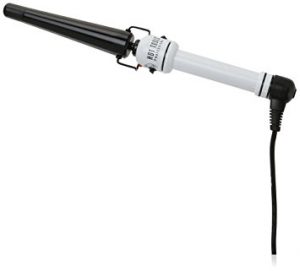
Have you ever wondered how people achieved those perfect curls before the invention of curling irons? Well, you’re in luck because we’re about to take a trip down memory lane and explore the fascinating history and evolution of curling irons. Get ready to be amazed by all the different techniques and tools that were used to create beautiful curls throughout the years.
When it comes to achieving curly hair, our ancestors sure were innovative. From ancient Egyptian women using hot tongs to create curls, to the invention of heatless curlers in the 19th century, people went to great lengths to achieve those bouncy waves. But it wasn’t until the 20th century that the modern curling iron as we know it today was invented.
Throughout the years, curling irons have evolved in terms of design, functionality, and safety measures. From early models that were heated directly on a stove to electric curling irons with adjustable heat settings, manufacturers have continuously improved the curling iron to make it more convenient and user-friendly. In this article, we’ll dive deeper into the different types of curling irons that have emerged over time and how they have revolutionized the way we style our hair.
So, if you’re interested in learning more about the fascinating history and evolution of curling irons, keep reading. Trust us, by the end of this article, you’ll have a newfound appreciation for that sleek and shiny curling iron sitting on your bathroom countertop.
The Invention of the Curling Iron
Curling irons have become an indispensable tool in the hairstyling industry, allowing individuals to easily achieve beautiful curls and waves in their hair. But have you ever wondered about the history behind these iconic hairstyling tools? From early curling techniques to the introduction of heat and the advancements in technology, the evolution of curling irons is truly fascinating.
Mention of Early Curling Techniques
Before the invention of curling irons, people relied on various methods to curl their hair. One of the earliest documented techniques dates back to ancient Egypt, where women used heated rocks to curl their hair. In ancient Greece, curling irons were made from metal and were heated over an open flame before being used to curl the hair.
The First Patent for a Curling Iron
The first patent for a curling iron was granted in the 19th century to Hiram Maxim, an American inventor. His curling iron was a revolutionary device that used a clamp mechanism to curl the hair. This design allowed for more control and precision compared to the earlier methods.
Introduction of Heat in Curling Irons
While Maxim’s invention was a significant advancement in hairstyling technology, it wasn’t until the introduction of heat that curling irons truly became efficient tools. In the late 19th century, marcel waving, a technique that used heated curling irons, gained popularity. Marcel waving involved heating the iron over a flame or stove and then wrapping sections of the hair around it to create curls.
Early Forms of Curling Irons
With the introduction of heat, curling irons began to take on various forms and were made from a variety of materials.
Metal Rods and Tongs
In the early 20th century, curling irons were often made from metal and came in the form of rods or tongs. These irons were heated over a flame or stove before being used to curl the hair. While effective, they posed a significant risk of burns and damage to the hair due to their high heat conductivity.
Bone and Ivory Curling Irons
As technology advanced, curling irons made from bone or ivory were introduced. These irons were often hollowed out and heated with a hot rod inserted into them. While these materials were less conductive of heat compared to metal, they were still prone to causing damage to the hair.
Unconventional Materials Used for Curling Irons
In addition to the traditional materials, some unconventional materials were used to make curling irons. For example, in the early 20th century, women would wrap their hair around a cylinder made from a wet brown paper bag and then place it on a gas burner to create curls. Although not the safest method, it highlights the creativity and resourcefulness of individuals when it came to achieving desired hairstyles.
The Rise of Electric Curling Irons
The introduction of electrically heated curling irons revolutionized the hairstyling industry, making curling hair more convenient and efficient.
Introduction of Electrically Heated Curling Irons
In the 1950s, electrically heated curling irons came onto the scene. These irons eliminated the need for open flames or stoves, making curling hair safer and more accessible. Electric curling irons were designed with a heating element embedded within the barrel, which allowed for more precise temperature control.
Advancements in Electric Curling Iron Technology
Throughout the years, advancements in technology have led to the development of electric curling irons with various features. For example, some irons now have adjustable heat settings, allowing individuals to customize the temperature based on their hair type and desired style. Other irons feature automatic shut-off mechanisms, providing an added layer of safety and peace of mind.
Innovations in Curling Iron Designs
As technology continued to evolve, so did the designs of curling irons. These innovations aimed to improve performance, efficiency, and user experience.
Clamp Curling Irons
Clamp curling irons, similar to the design created by Hiram Maxim, remain popular to this day. The clamp mechanism allows for easy sectioning of hair and provides a secure grip while curling. This design is particularly beneficial for individuals who struggle with coordination or have difficulty manipulating the hair.
Spring-Loaded Curling Irons
Spring-loaded curling irons were introduced to further simplify the curling process. These irons feature a built-in spring that automatically clamps the hair, eliminating the need for manually squeezing the handle. This design provides a consistent and even curl without requiring the user to apply excess pressure.
Tourmaline-Infused Curling Irons
In recent years, tourmaline-infused curling irons have gained popularity due to their ability to generate negative ions. Negative ions help to seal the hair cuticle, reducing frizz and creating a smoother and shinier finish. Additionally, tourmaline-infused irons distribute heat more evenly, minimizing heat damage.
Curling Irons in the Modern Era
In today’s hairstyling industry, curling irons have become more advanced and versatile, offering a range of features to meet the diverse needs of individuals.
Curling Irons with Adjustable Temperature
Many modern curling irons now come with adjustable temperature settings, allowing individuals to choose the appropriate heat level for their hair type. This feature is particularly beneficial for those with fine or thin hair that is more susceptible to heat damage.
Curling Irons with Automatic Shut-Off
Safety is a top priority when it comes to hairstyling tools. Curling irons with automatic shut-off technology have become increasingly common. These irons are designed to turn off after a certain period of inactivity, reducing the risk of accidents and fire hazards.
Curling Irons with Ceramic Coating
Curling irons with a ceramic coating have gained popularity for their ability to distribute heat evenly and minimize heat damage. The ceramic coating also provides a smoother surface, reducing friction and preventing hair from snagging or pulling during the curling process.
Impact of Curling Irons on Hairstyling Trends
The invention and evolution of curling irons have had a profound impact on hairstyling trends throughout history.
The Influence of Curling Irons on Popular Hairstyles
Curling irons have played a significant role in shaping popular hairstyles, from the elegant curls of the 1920s to the beachy waves of the 2000s. These irons have allowed individuals to experiment with various curl patterns and styles, empowering them to express their creativity and individuality.
Curling Irons in Film and Fashion
Curling irons have also had a significant presence in film and fashion industries. Hairstylists utilize curling irons to create iconic looks for characters on the big screen, further solidifying the importance of these tools in the world of hairstyling.
Celebrity Endorsements and Curling Iron Trends
Celebrity endorsements have played a crucial role in popularizing curling irons and creating trends. From red carpet events to social media, celebrities frequently showcase their stunning curled hairstyles, prompting many individuals to emulate their looks using curling irons.
The Safety Concerns of Curling Irons
While curling irons have undoubtedly revolutionized hairstyling, it is essential to be aware of the safety concerns associated with their use.
Risk of Burns and Heat Damage
Curling irons can reach high temperatures, posing a risk of burns to the skin and heat damage to the hair. It is crucial to exercise caution and follow proper guidelines when using these tools to minimize the risk of injury.
Precautionary Measures for Safe Curling Iron Use
To ensure safe curling iron use, it is recommended to start with clean and dry hair, apply a heat protectant spray, and work in small sections. It is also important to avoid leaving the iron on the hair for too long, as this can lead to excessive heat exposure and damage.
Professional Use of Curling Irons
Curling irons are not only popular among individuals for personal use but also widely utilized by professionals in the hairstyling industry.
Curling Irons in Salons and Styling Studios
Curling irons are a staple tool in salons and styling studios, where hairstylists use them to create a range of hairstyles for their clients. These tools allow professionals to achieve precise and consistent curls with ease.
Different Curling Techniques by Professionals
Hairstylists employ various curling techniques to achieve different curl patterns and styles. From traditional wrapping techniques to more advanced methods such as finger waves or pin curling, professionals have mastered the art of curling hair using curling irons.
Alternative Methods of Curling Hair
While curling irons are the go-to tool for many individuals, there are alternative methods available for those who prefer heatless or temporary curling solutions.
Heatless Curling Methods
Heatless curling methods, such as using curling rods, flexi rods, or braiding damp hair, can create curls without the need for heat. These techniques provide a gentler and healthier alternative, particularly for individuals with fragile or damaged hair.
Temporary Curling Solutions
Temporary curling solutions, including foam rollers, sponge curlers, or velcro rollers, offer individuals the ability to achieve curls or waves without the use of heat. These options are easy to use and allow for a variety of curl sizes and styles.
Chemical-Based Curling Techniques
Chemical-based curling techniques, such as perming or texturizing treatments, can alter the structure of the hair to create permanent curls or waves. These methods are typically performed by professionals in a salon setting and require specific expertise to ensure optimal results.
Conclusion
The history and evolution of curling irons highlight the remarkable advancements in hairstyling technology. From the early techniques of using heated rocks to the introduction of electrically heated irons, curling irons have continually evolved to provide individuals with more efficient and safer hairstyling options. With their ability to create versatile and stunning curls, curling irons have become a staple tool in the world of hairstyling, leaving a significant impact on popular hairstyles, film and fashion trends, and the way individuals express their personal style. However, it is essential to prioritize safety and exercise caution when using these tools to prevent burns and heat damage. Whether you prefer the convenience of electric curling irons or the creativity of alternative curling methods, there is no denying the impact and transformative power of curling irons in the modern era.
